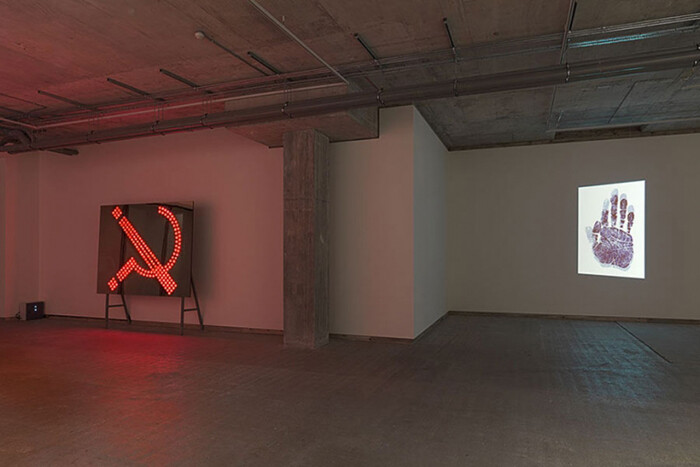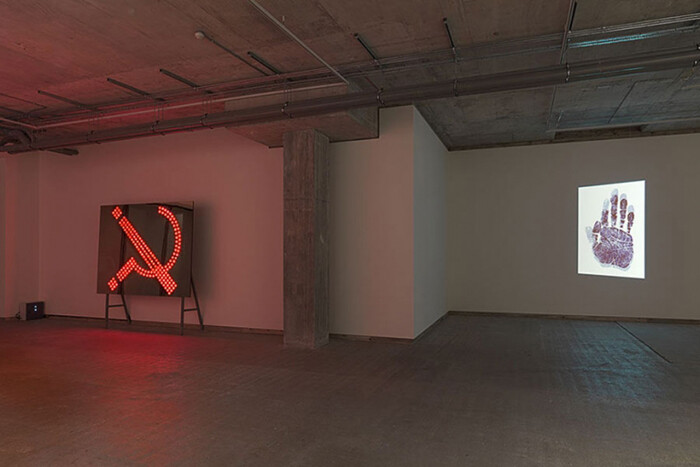The crossed hammer-and-sickle insignia of the Bolshevik revolution has a sense of certainty to it. But it’s an old design, and a lot has happened since it first declared the coming triumph of the proletariat. So Marks (2011) the first work you see on entering Frith Street Gallery, has a sort of shock-value to its reworking of the symbol, opening up an idea that had seemed relegated to history. Set into a large mirrored rectangle is an array of red lights in the shape of an exclamation mark (standing in for the hammer) and a question mark (for the sickle), with the two forms lighting up in slow sequence. No longer the herald of the revolutionary momentum of 1917, in the hands of New Delhi-based Raqs Media Collective the hammer-sickle form becomes a brilliantly succinct visual pun, which crystalizes the acute sense of uncertainty that courses through the current turmoil of the global political present. It’s a mix of exclamation and confusion that knows what it rejects but cannot define what it wishes to claim. There’s an urgency in the demands for something new, but what?
These recent works by the collective aren’t agitprop, however. Rather, they variously express the group’s philosophical musings on how time, the individual, and the collective are organized (or disorganized) by political power. Marks’s companion piece Strike (2011) makes this explicit— cut out of the metal, the phrase IT IS THE MOMENT TO STRIKE AT TIME stands facing the viewer like a billboard. The old political strategy of the strike—the interruption of the process of capital’s exploitation of labor by labor’s refusal to work—is here supplanted by something more abstract, more conceptual: the idea of continuity disrupted, the idea of indefinite time, of “things” going on for ever as opposed to the demand for an ongoing present full of action and event.
There is, however, an awkward historical irony at work here (at least for this Marxist critic). Marks and Strike were originally commissioned as temporary works for the foyer of the French Communist Party’s headquarters in Paris. Yet if ever there was a political party guilty of attempting to divert the revolutionary event, to arrest the moment of upheaval, it was the French Communist Party, in the midst of the students’ and workers’ revolt in May 1968. Judging the moment not to be sufficiently revolutionary, the PCF opted for the status quo, leaving the uprising to be crushed.
Removed from that context however, these works hover… their historical question remains unanswered. Two other works ruminate on the power of the ruling class. Untold Intimacy of Digits (2011) is a projected digital animation of a handprint, taken from a Bengalese peasant, in 1858, by a British colonial administrator. It’s one of the first instances, Raqs contends, of a print of the human body being used for legal identification—of an individual body becoming representable to the bureaucratic processes of the state. The blue-black handprint slowly curls and extends its fingers, counting. “It haunts its way into our imaginations as a countdown towards infinity, a quiet subversion of the vanity of quantification—the futile hope that a human being can be reduced to numbers,” or so says the press release. The image of the hand is reprised in a wall-work (Re-Writing on the Wall, 2011), in which laser-etched metallic renditions of the hand, mounted on Perspex, spell out (in American sign language) a short poem (transcribed on the wall nearby) which dwells on the difference between “I” and “we,” on how the collective and individual both constrain and empower each other.
All of this, of course, only begins to work if you choose to engage with the kind of global-left discourse that Raqs seem ensconced in; the language of Alain Badiou’s theorizing of the political “event,” or of Hardt and Negri’s “multitude,” and so on. Given that many people are engaged in such questions (applying such terms), this isn’t such a problem. But, as evidenced by the uncharacteristically involved press text (go read it on the website, it’s good), such works depend on reconstituting the intellectual analysis and political perspective that brought them into being, otherwise they remain cryptic, cool, affectless. This is art for political hipsters, who get the references and get the backstory, and are comfortable seeing artworks only as ciphers for discourses conducted elsewhere. And if one wanted to attempt some form of political criticism, one could ask whether the strangely detached preoccupation with time, measurement, political history, and the political body only truly reflects and reconfirms the problem that besets contemporary radical politics—that the urgently felt desire for action to change the present isn’t matched by a coherent vision of what future to replace it with, or how to achieve it. Marks and Strike may ask questions of what might still be possible, but they hint at the trouble of discovering that no one may have any answers, and that our dissatisfactions with the present are constrained by the intuition that any solution offered might be nothing more than “guess-work.”
But these are aesthetic criticisms too; there is little in Raqs’s visual idiom that poses any threat to the present. There is nothing politically dangerous about these elegant, pensive objects, which seem to be waiting for something to happen. Hammer-blows and sickle-cuts may have their analogues in aesthetic form, but it is perhaps not yet time for those here.






